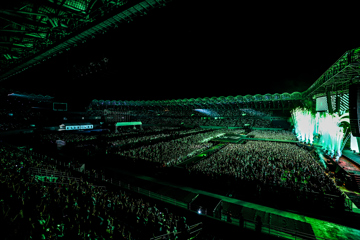Fever Pitch
After we get back from Australia, I think the first part of 2014, in the first four months or so, we’re going to focus on just writing these songs.

Canadian crooners Half Moon Run haven't just had a productive 18 months; they've had the kind of time that anyone making music dreams about. But then again, when you're pushing the folk boundaries in a time that lauds folk music like it's as good as hair metal in the late '80s, you're bound to gather a multi-faceted legion of followers in absolutely no time. However, how to spark the attention and prick the ears of your fellow musician? Now that's the hard part. Mumford & Sons, Of Monsters & Men, Metric and Patrick Watson took the band on the road as support, while organisers at South By South West, Glastonbury, Lollapalooza and Reading all jumped to have them play sets at their respective festivals. Though he remains equal parts coy and humble, Conner Molander agrees it's easy to see just why the international buzz has hit fever pitch.
“Aaah, what a blur!” he laughs. “Eighteen months we've been on tour and so it feels, to me at least, like the shows have been getting better. Plus we've upgraded to our tour bus recently – so that's been really nice. But overall, the success doesn't feel that different. It's good to have a sense of recognition and all that; definitely looking forward to writing some new songs. Being on the road for so long, it's been hard to write. But everything has been very exciting for sure. Glastonbury was amazing, really amazing. And there were a couple of festivals over the summer that were really good. And like, Woodford Folk Festival last year – that was a really amazing vibe too.
“There's been some funny stories from backstage,” Molander admits, almost with a sly giggle. “Mumford & Sons, well obviously we've become good friends with them since we toured with them so much and at Glastonbury there was a funny situation where Thom Yorke was backstage; he wasn't playing but he did a secret DJ show and we went and watched him later and bumped into him in the bar. At the time, I had purple glitter all over my face and I was kind of in party mode, so I just saw him and kind of patted him on the shoulder and he gave me a little bow.”
Listening to their debut album, Dark Eyes, there's truly the sense that Half Moon Run are not entirely committed to folk music, but instead choose to invite elements like layered harmonies, intricate guitar, indie, pop and even a hint of subtle electronica. Having played the album more times than he'd care to remember over the last 18 months, Molander admits he can't wait to settle for a bit and start writing some new songs.
Don't miss a beat with our FREE daily newsletter
“There's a lot of ideas going around but we've been on tour for so long, it's really hard to consolidate anything concrete, but after we get back from Australia, I think the first part of 2014, in the first four months or so, we're going to focus on just writing these songs. So hopefully we can work out an album's worth of stuff then and tour and record somewhere in the fall. We have limited success developing ideas on the road honestly; little sparks come up now and then but in the past our writing process takes weeks and months of writing on our own in our jam space. Time on the road, it's a little bit exhausting so your creative energy is a little spent and you need a bit of routine and a life back in Canada to finish off those songs.
“Our fourth member just joined, so now we all work together on the songs. We bring the ideas to our jam space and just find an instrument and see who responds to an idea. We've had songs that come together in eight hours, but usually it can take weeks and months. It's nice because if we have a vibe that hasn't been achieved before, it remains collaborative so that it eventually can sound like us. It's case by case, song by song. We're experimenting with more instruments and, in some cases, we're getting more electronic and in some cases more folky. I bought a pedal steel guitar and have been playing around with that and we're getting other auxiliary acoustic instruments involved. We're getting more creative with our arrangements while, at the same time, getting more simple. But it's tough to say really where it's going to go.”






